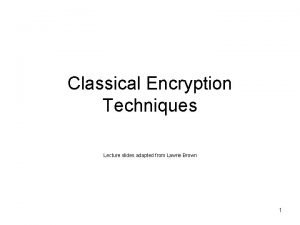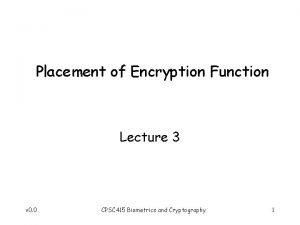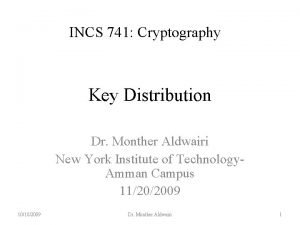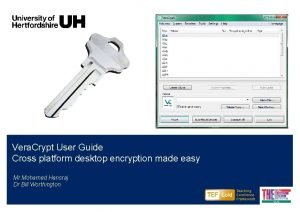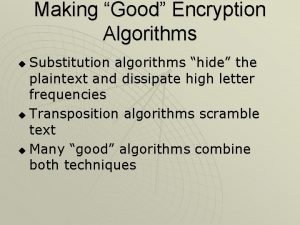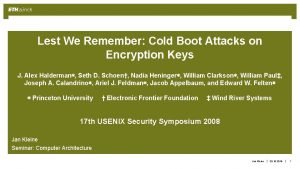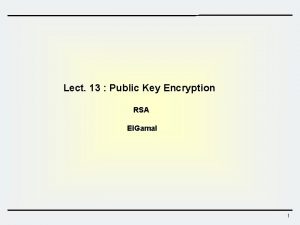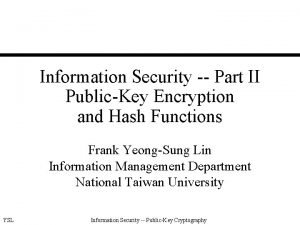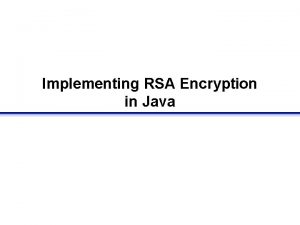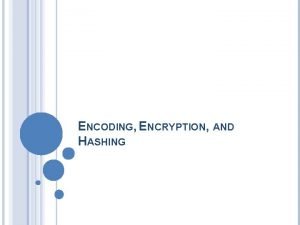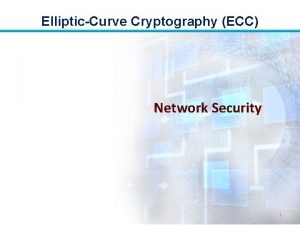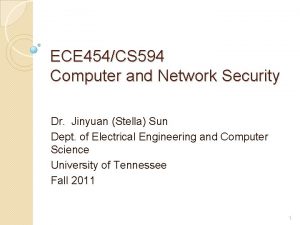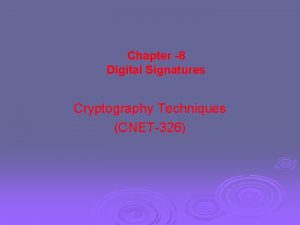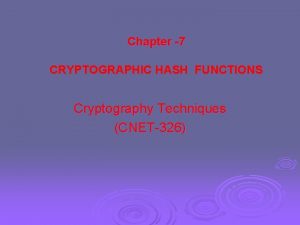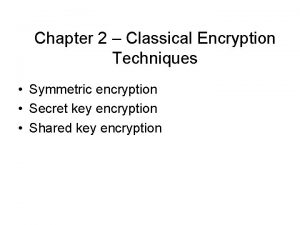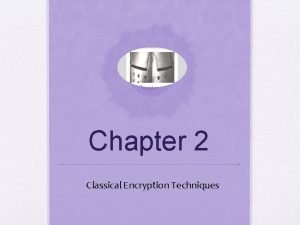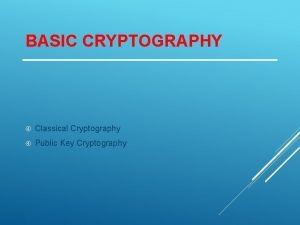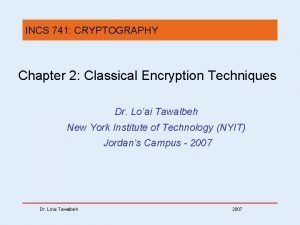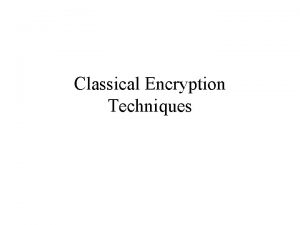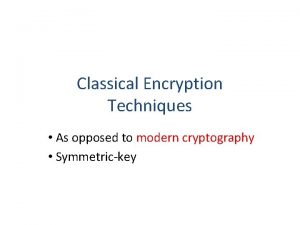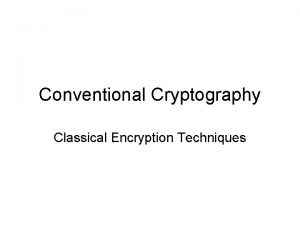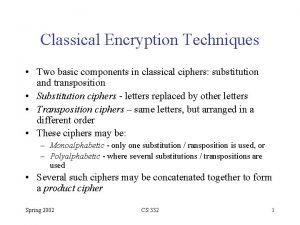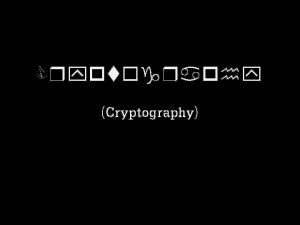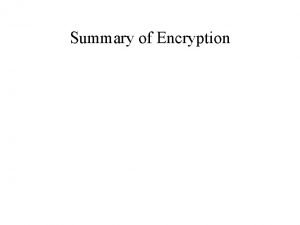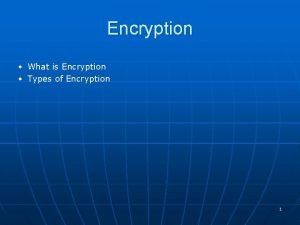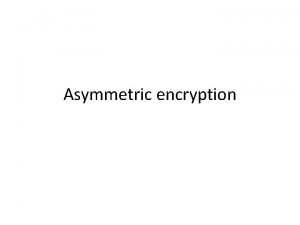Chapter 1 CLASSICAL ENCRYPTION TECHNIQUES Cryptography Techniques CNET326

















- Slides: 17

Chapter -1 CLASSICAL ENCRYPTION TECHNIQUES Cryptography Techniques (CNET-326)

Symmetric Encryption Ø Or conventional / private-key / single-key Ø Sender and recipient share a common key Ø All classical encryption algorithms are private-key

Some Basic Terminology Ø Plaintext - original message Ø Ciphertext - coded message Ø Cipher - algorithm for transforming plaintext to ciphertext Ø Key - info used in cipher known only to sender/receiver Ø Encipher (encrypt) - converting plaintext to ciphertext Ø Decipher (decrypt) - recovering ciphertext from plaintext Ø Cryptography - study of encryption principles/methods Ø Cryptanalysis (codebreaking) - study of principles/ methods of deciphering ciphertext without knowing key Ø Cryptology - field of both cryptography and cryptanalysis

Symmetric Cipher Model

Requirements Ø Two requirements for secure use of symmetric encryption: l l a strong encryption algorithm a secret key known only to sender / receiver Ø mathematically have: Y = E(K, X) X = D(K, Y) Ø assume encryption algorithm is known Ø implies a secure channel to distribute key

Cryptography Ø can characterize cryptographic system by: l Type of encryption operations used • • • l substitution transposition product Number of keys used • single-key or private • two-key or public l way in which plaintext is processed • Block • Stream

Cryptanalysis Ø objective to recover key not just message Ø general approaches: l l cryptanalytic attack brute-force attack Ø if either succeed all key use compromised

Cryptanalytic Attacks Ø ciphertext only l only know algorithm & ciphertext, is statistical, know or can identify plaintext Ø known plaintext l know/suspect plaintext & ciphertext Ø chosen plaintext l select plaintext and obtain ciphertext Ø chosen ciphertext l select ciphertext and obtain plaintext Ø chosen text l select plaintext or ciphertext to en/decrypt

Classical Substitution Ciphers Ø where letters of plaintext are replaced by other letters or by numbers or symbols Ø or if plaintext is viewed as a sequence of bits, then substitution involves replacing plaintext bit patterns with ciphertext bit patterns

Caesar Cipher Ø earliest known substitution cipher Ø by Julius Caesar Ø first attested use in military affairs Ø replaces each letter by 3 rd letter on Ø example: meet me after the toga party PHHW PH DIWHU WKH WRJD SDUWB

Caesar Cipher Ø can define transformation as: abcdefghijklmnopqrstuvwxyz DEFGHIJKLMNOPQRSTUVWXYZABC Ø mathematically give each letter a number abcdefghij k l m n o p q r s t u v w x y z 0 1 2 3 4 5 6 7 8 9 10 11 12 13 14 15 16 17 18 19 20 21 22 23 24 25 Ø then have Caesar cipher as: c = E(k, p) = (p + k) mod (26) p = D(k, c) = (c – k) mod (26)

Monoalphabetic Cipher rather than just shifting the alphabet Ø could shuffle (jumble) the letters arbitrarily Ø each plaintext letter maps to a different random ciphertext letter Ø hence key is 26 letters long Ø Plain: abcdefghijklmnopqrstuvwxyz Cipher: DKVQFIBJWPESCXHTMYAUOLRGZN Plaintext: ifwewishtoreplaceletters Ciphertext: WIRFRWAJUHYFTSDVFSFUUFYA

Polyalphabetic Ciphers polyalphabetic substitution ciphers Ø improve security using multiple cipher alphabets Ø make cryptanalysis harder with more alphabets to guess and flatter frequency distribution Ø use a key to select which alphabet is used for each letter of the message Ø use each alphabet in turn Ø repeat from start after end of key is reached Ø

Vernam Cipher Ø ultimate defense is to use a key as long as the plaintext Ø with no statistical relationship to it Ø invented by AT&T engineer Gilbert Vernam in 1918 Ø originally proposed using a very long but eventually repeating key

One-Time Pad if a truly random key as long as the message is used, the cipher will be secure Ø called a One-Time pad Ø is unbreakable since ciphertext bears no statistical relationship to the plaintext Ø since for any plaintext & any ciphertext there exists a key mapping one to other Ø can only use the key once though Ø problems in generation & safe distribution of key Ø

Row Transposition Ciphers Ø is a more complex transposition Ø write letters of message out in rows over a specified number of columns Ø then reorder the columns according to some key before reading off the rows Key: 4312567 Column Out 3 4 2 1 5 6 7 Plaintext: a t t a c k p ostpone duntilt woamxyz Ciphertext: TTNAAPTMTSUOAODWCOIXKNLYPETZ

Steganography Ø An alternative to encryption Ø Hides existence of message l l l using only a subset of letters/words in a longer message marked in some way using invisible ink hiding in LSB in graphic image or sound file Ø has drawbacks l high overhead to hide relatively few info bits Ø advantage is can obscure encryption use
 Cryptography techniques
Cryptography techniques Classical encryption techniques in network security
Classical encryption techniques in network security Classical encryption techniques
Classical encryption techniques Location and placement of encryption function
Location and placement of encryption function Monther aldwairi
Monther aldwairi Classical plating technique
Classical plating technique Vera crypt
Vera crypt Homomorphic encryption standard
Homomorphic encryption standard Symmetric encryption advantages and disadvantages
Symmetric encryption advantages and disadvantages Exchange hosted encryption
Exchange hosted encryption Making good encryption algorithms
Making good encryption algorithms Lest we remember: cold boot attacks on encryption keys
Lest we remember: cold boot attacks on encryption keys Rsa public-key encryption and signature lab solution
Rsa public-key encryption and signature lab solution Public key encryption
Public key encryption Rsa algorithm in java
Rsa algorithm in java Encoding and encryption
Encoding and encryption Encryption decrypti
Encryption decrypti Crc encryption
Crc encryption


